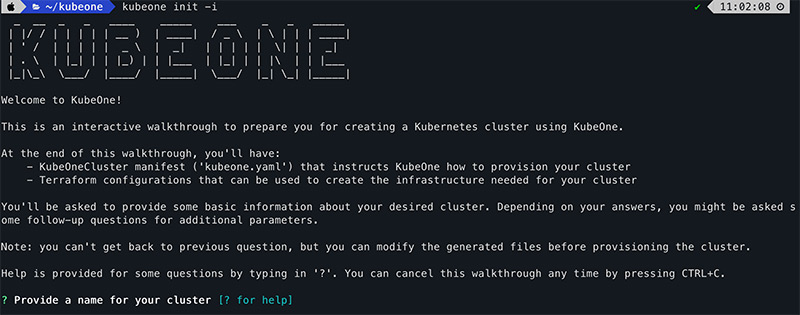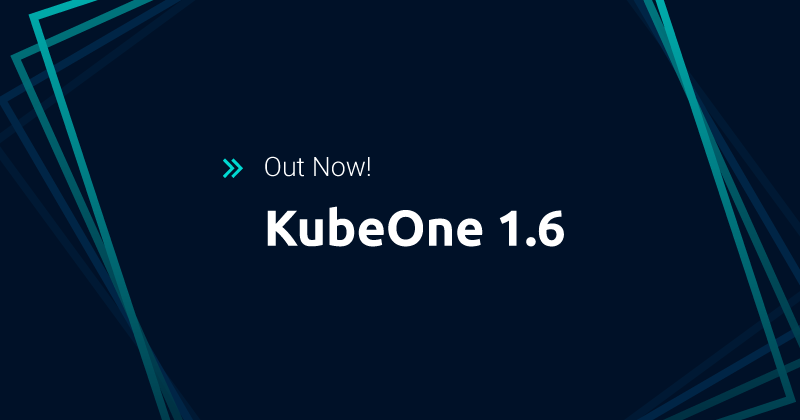PRESS RELEASE
We are excited to announce the release of KubeOne 1.6. KubeOne is completely open source and provides organizations with full lifecycle management of clusters, including provisioning, upgrading, and repairing them whenever necessary. It’s a command line interface (CLI) tool, so it’s perfect for automation or orchestration scripts.
“With KubeOne 1.6, we wanted to make it easier than ever for users to get started with Kubernetes. As such, improving the user experience was a top priority for the development team. With the latest version, KubeOne has become even more streamlined, intuitive, and user-friendly than before, making it easier than ever for our users,” said Sebastian Scheele, CEO at Kubermatic.
The highlights of KubeOne 1.6 are as follows:
Enhanced User Experience With Helm Based Addons
Long ago, we introduced “Addons” as a way to deploy Kubernetes resources during cluster reconciliation. Addons proved to be convenient and were used to deploy various components such as CNIs, CCM/CSI, and more. However, addons only support plain YAML files. This can be problematic as many components are now shipped as Helm charts, affecting the user experience.
KubeOne 1.6 introduces Helm-based addons to improve the user experience. Users just provide a list of Helm charts to deploy in the KubeOneCluster manifest, for example
apiVersion: kubeone.k8c.io/v1beta2
kind: KubeOneCluster
versions:
kubernetes: 1.26.1
cloudProvider:
aws: {}
helmReleases:
- releaseName: ksm
chart: kube-state-metrics
repoURL: https://prometheus-community.github.io/helm-charts
namespace: kube-state-metrics
version: 4.25.0
KubeOne 1.6 integrates Helm for the full lifecycle of Helm charts, including installation, updates, and uninstallation if needed. More information about this feature can be found in the official documentation here.
Get Started With KubeOne With Just 3 Commands
Our goal is to simplify the KubeOne setup process by only requiring the KubeOne binary.
Previously, users had to obtain Terraform files from GitHub or a release archive, manually create a KubeOneCluster manifest and set Terraform variables if using our configurations.
Users can now get started with the newly-added `kubeone init` subcommand! This new subcommand will ask the user for a bunch of parameters, and based on the provided parameters it’s going to generate KubeOneCluster manifest and Terraform configurations and variables.
This command can be used in two ways:
- by providing parameters using flags or
- by using the interactive mode. The interactive mode will guide the user through the process step-by-step and give recommendations on which features might be valuable based on the setup.

With KubeOne’s new setup process, you’ll only need to run three commands to get started with Kubernetes: terraform init, terraform apply, and kubeone apply.
Experimental Support For Dual-Stack Clusters
KubeOne 1.6 comes with experimental support for IPv4/IPv6 Dual-Stack clusters on AWS and bare metal clusters.
Dual-Stack support gives users an option to use both IPv4 and IPv6 addresses for pod networking. This includes creating Services and exposing workloads via both IPv4 and IPv6 addresses.
This feature is currently available only for newly-created clusters by setting the following option in the KubeOneCluster manifest:
apiVersion: kubeone.k8c.io/v1beta2
kind: KubeOneCluster
versions:
kubernetes: 1.26.1
cloudProvider:
aws: {}
clusterNetwork:
ipFamily: "IPv4+IPv6"
For more details about available options, please consider our API reference here.
Support for the Latest Kubernetes Releases
KubeOne 1.6 introduces support for two new Kubernetes minor releases: 1.25 and 1.26.
This allows users to access all the latest features in the upstream development, as well as, to easily stay on a supported Kubernetes version.
Additionally, KubeOne can manage up to Kubernetes 1.24.
Please check the upgrade guidelines here and the Kubernetes compatibility matrix for more information.
These are just a few of the amazing features included in this release. Be sure to review the full changelog for a complete list of enhancements, updates, and bug fixes that will enhance your experience. Follow us on GitHub for updates on future developments - we have exciting plans for KubeOne 1.7, including further enhancements to dual-stack support, improvements to Helm addons, and more!
KubeOne 1.6 is available for use as of 28 February 2023.
Additional Resources
- KubeOne Documentation
- KubeOne 1.6 Release Changelog






